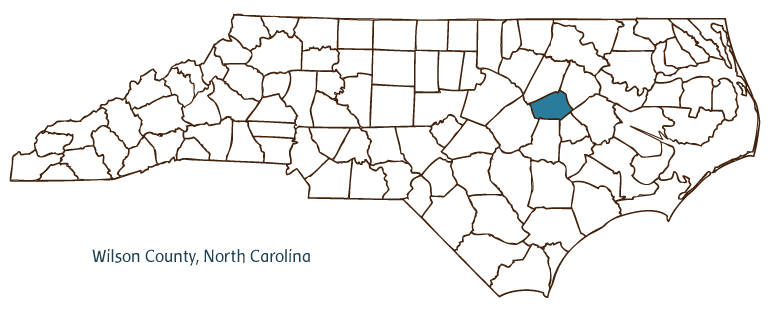Wilson County Resources
- View All:
- Biographies
- Monuments
- locations
Copyright Notice: This article is from the Encyclopedia of North Carolina edited by William S. Powell. Copyright © 2006 by the University of North Carolina Press. Used by permission of the publisher. For personal use and not for further distribution. Please submit permission requests for other use directly to the publisher.

Wilson County, located in the Coastal Plain region of North Carolina, was formed in 1855 from Edgecombe, Nash, Johnston, and Wayne Counties; it was named for Louis Dicken Wilson, a delegate to the constitutional convention of 1835, member of the General Assembly, and hero of the Mexican War. Early inhabitants of the area included the Tuscarora Indians, followed by English settlers. Wilson, the county seat, was incorporated in 1849 and has the same namesake as the county. Other Wilson County communities include Elm City, Saratoga, Sims, Black Creek, Buckhorn Crossroads, and Stantonsburg. Notable physical features of the county include the Buckhorn Reservoir, Mill Run, and Marsh, Hominy, Cattail, Aycock, and Goss Swamps.
Wilson County is known for its pork barbecue and produces agricultural goods such as tobacco, soybeans, wheat, sweet potatoes, cucumbers, cotton, swine, and poultry. Manufactured products include tires, apparel, glass bottles, fire protection equipment, and fiberglass tubs and showers.
Wilson County landmarks and historic sites include the Lucas-Barnes House, built in 1853, and the James Scarborough House, built ca. 1821, as well as several buildings within the Historic Wilson district-notable among them the Atlantic Coast Line Railroad Passenger and Freight Station, constructed in 1924. BB&T (Branch Banking and Trust Company) was established in 1872 in Wilson. Barton College, also in Wilson, was established, as Atlantic Christian College, in 1902. Wilson County cultural institutions include the Arts Council of Wilson, the Children's Theatre, the British Brass Band, the Play House, and Imagination Station. The county hosts festivals and annual events such as the Spring Festival, Whirligig Festival, Halloween Party and Parade, and Downtown Lights Up and Christmas Parade. In 2004 Wilson County's population was estimated to be 76,400.
For an annotated history of the county's formation, with the laws affecting the county, boundary lines and changes, and other origin information, visit these references in The Formation of the North Carolina Counties (Corbitt, 2000), available online at North Carolina Digital Collections (note, there may be additional items of interest for the county not listed here):
County formation history: https://digital.ncdcr.gov/Documents/Detail/the-formation-of-the-north-ca...
Index entry for the county: https://digital.ncdcr.gov/Documents/Detail/the-formation-of-the-north-ca...
Additional resources:
Corbitt, David Leroy. 2000. The formation of the North Carolina counties, 1663-1943. https://digital.ncdcr.gov/Documents/Detail/the-formation-of-the-north-carolina-counties-1663-1943/3692099?item=4553233 (accessed June 20, 2017).
Wilson County Government: https://www.wilsoncountync.gov/
Wilson County Chamber of Commerce: https://www.wilsonncchamber.com/
Wilson Visitors Center: https://wilson-nc.com/
North Carolina Digital Collections (explore by place, time period, format): https://digital.ncdcr.gov
Image credits:
Rudersdorf, Amy. 2010. "NC County Maps." Government & Heritage Library, State Library of North Carolina.
Bayley, Elizabeth. "Wilson County." NCpedia. State Library of NC. 2006. https://www.ncpedia.org/geography/wilson.